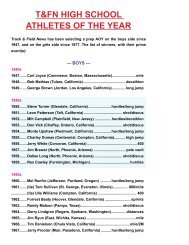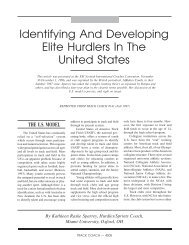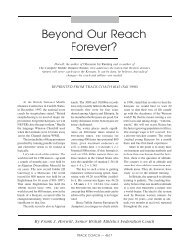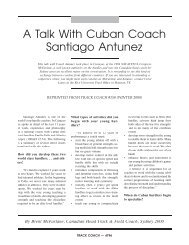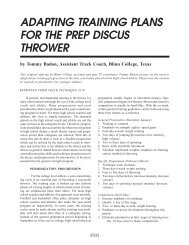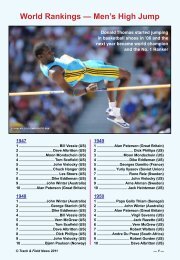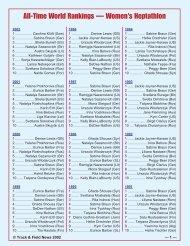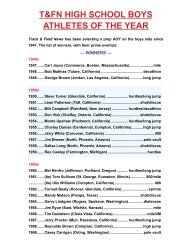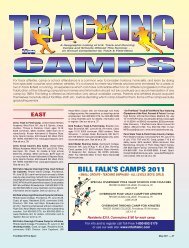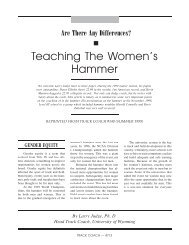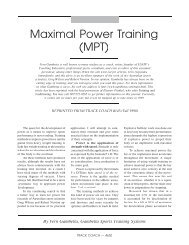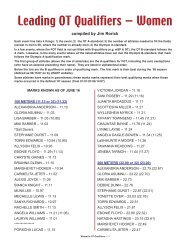SPEED TRAINING - Track & Field News
SPEED TRAINING - Track & Field News
SPEED TRAINING - Track & Field News
You also want an ePaper? Increase the reach of your titles
YUMPU automatically turns print PDFs into web optimized ePapers that Google loves.
WEIGHT <strong>TRAINING</strong><br />
Weight training has two major rationales. One is<br />
to provide total body conditioning to prevent muscle<br />
imbalances, and to provide general muscle-tendon-ligament<br />
strengthening to reduce injury and better perform<br />
workouts. The second is to increase muscle group strength,<br />
through either increased recruitment of muscle fibers or<br />
strengthening of muscle fibers (both occur), to increase<br />
the ability to apply power to the ground.<br />
Current training theory for weight lifting usually has<br />
the athlete begin with 8-12 repetitions of an exercise,<br />
proceeding to sets of 6 or less (at appropriate repetition<br />
maximums—RMs), as fast-twitch muscle fibers are not<br />
significantly trained above 6 RM. Variety, or set-rep<br />
changes are used throughout the year to avoid stagnation.<br />
7 Maintenance work (3-4 sets of 5 reps, 1-2 week)<br />
should be done in the peaking/resting cycles.<br />
Excluding warm-up sets, set-reps structure could be:<br />
4-6 weeks general conditioning—3-4 sets of 8-10 reps;<br />
normal six week cycles—4-5 sets of 5 reps, or 5-5-3-3-<br />
(3), or 5-5-3-2-3; peaking/resting cycles—3 sets of 5 reps<br />
1-2 x week as able-in all other cycles lift 3 x week or 5<br />
x over a two-week period.<br />
Current program: Weeks 1-4 (Cycle I): 4 sets of 10<br />
reps. Weeks 5-9 (Cycle II): sets of 10-5-5-3-3-3. Week<br />
10 (end of Cycle II): Max in key lifts. Christmas break:<br />
as able. This series is then repeated during the six-week<br />
cycles (Cycles Ill and V), with a maintenance program<br />
during the peaking/resting cycles (IV, VI). Weight lifted<br />
per exercise is expected to be progressive throughout the 5<br />
weeks of 10-5-5-3-3-3, then maxed for 1 week, then going<br />
to a reduced resting phase (peaking/resting cycles).<br />
The current lifts are: squats (parallel), bench press,<br />
arm curls, tricep curl (french press), incline press, leg<br />
press (machine), calf rise, hamstring curl (machine), leg<br />
extension (machine), and lunges.<br />
PLYOMETRICS<br />
Done correctly, plyometric exercises are very intense,<br />
and their major rationale is to increase the ability to apply<br />
force to the ground very quickly. Since great sprinters are<br />
able to apply large force to the ground from small knee<br />
angles (less knee bend and less leg flexion throughout<br />
the force application) with short ground contact times,<br />
plyometric activities should mimic such actions. They<br />
should be very fast with short ground contact times, and<br />
should use shallow knee flexion. 8<br />
Our current major plyometric activity was to be flying<br />
start, single-leg hops (20m sprint start, 30m hopping).<br />
However, the skill level of our athletes in performing this<br />
activity was not high enough, and a learning process is<br />
now occurring.<br />
Instead, we are going more general plyometric work,<br />
including bounding, skipping, and hopping without a flying<br />
start (200-600m of varied activity). We do these once a<br />
week and intend to do them twice a week (1 x week fast<br />
plyometric activity, 1 x week general plyometric activity)<br />
when skill levels are increased (we wish to avoid injuries<br />
caused by the unskilled doing an explosive activity).<br />
FORM WORK<br />
Form work, or isolating and training various facets<br />
of sprinting form, has been a part of much sprint training.<br />
However, there are some questions as to its efficacy.<br />
Recent biomechanical analysis of arm motion, for<br />
example, has failed to find any great significance in the<br />
specifics of arm motion to sprinting ability. Earlier studies<br />
also point out that neuromuscular coordination is very<br />
specific to the speed of movement. That is, form work has<br />
to be done at event speeds to properly stimulate and train<br />
the event neuromuscular coordination (firing sequence of<br />
the muscles). Form work does have a purpose. Its uses<br />
are: 1. as a warm-up acitivty; 2. to develop a feeling for<br />
muscle movements that can be transferred to high speed<br />
activity, and, 3. to strengthen certain muscle groups.<br />
Under purpose 1, the slower, rhythmical form of<br />
sprinting loosens, stretches, and warms up the muscles for<br />
sprinting. Under 2, it can train the athlete to recognize what<br />
muscle groups are doing, and should do, during sprinting<br />
(of varying importance: the relaxed and quick recovery<br />
of the foot and leg after ground contact, creating a short,<br />
level movement efficiently; allowing knee lift to occur,<br />
as it will, without forcing it or preempting it, to drive or<br />
stab the foot quickly to and off the ground after knee lift<br />
has occurred). Under 3, the hamstrings, hip flexors and<br />
extensors, and ankle flexors can be strengthened.<br />
Training examples: 3-5 repetitions, over 30-l00m for<br />
all drills—(1) fast high-knee drill, small steps (1-3 feet in<br />
length); (2) hamstring drill (kick foot to rear aggressively<br />
and quickly), small steps (1-2 feet in length); (3) high<br />
skips (emphasize ankle extension and hip extension—these<br />
are skipping strides with a large vertical movement); (4)<br />
quick foot drill (start slowly and pick up speed with each<br />
quick foot movement—about every third stride stab the<br />
foot to the ground very quickly, after the completion of<br />
knee lift (do not preempt knee lift)—this is similar to a<br />
hurdler’s trail leg drill except for the more normal motion<br />
of the “trail” leg-alternate legs—at speed, return to normal<br />
sprint motion and ease off). We currently do such form<br />
work 3x/week as a warm-up acitvity, and think of it as<br />
rhythmical plyometrics.<br />
Form work is probably best practiced as a holistic<br />
activity (the body acting as a coordinated whole) during<br />
near-full speed and full speed sprinting. At speed, the<br />
athlete concentrates on relaxation, smooth, quick recovery,<br />
and getting the foot to the ground and off quickly, after<br />
knee lift occurs.<br />
3291



